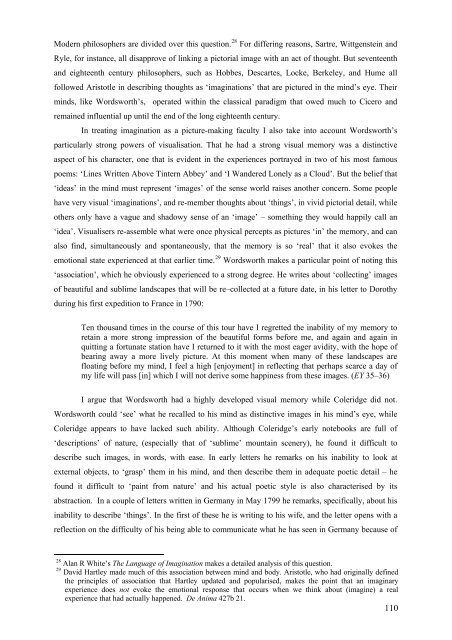Contents - ResearchSpace@Auckland - The University of Auckland
Contents - ResearchSpace@Auckland - The University of Auckland
Contents - ResearchSpace@Auckland - The University of Auckland
Create successful ePaper yourself
Turn your PDF publications into a flip-book with our unique Google optimized e-Paper software.
Modern philosophers are divided over this question. 28 For differing reasons, Sartre, Wittgenstein andRyle, for instance, all disapprove <strong>of</strong> linking a pictorial image with an act <strong>of</strong> thought. But seventeenthand eighteenth century philosophers, such as Hobbes, Descartes, Locke, Berkeley, and Hume allfollowed Aristotle in describing thoughts as ‘imaginations’ that are pictured in the mind’s eye. <strong>The</strong>irminds, like Wordsworth’s, operated within the classical paradigm that owed much to Cicero andremained influential up until the end <strong>of</strong> the long eighteenth century.In treating imagination as a picture-making faculty I also take into account Wordsworth’sparticularly strong powers <strong>of</strong> visualisation. That he had a strong visual memory was a distinctiveaspect <strong>of</strong> his character, one that is evident in the experiences portrayed in two <strong>of</strong> his most famouspoems: ‘Lines Written Above Tintern Abbey’ and ‘I Wandered Lonely as a Cloud’. But the belief that‘ideas’ in the mind must represent ‘images’ <strong>of</strong> the sense world raises another concern. Some peoplehave very visual ‘imaginations’, and re-member thoughts about ‘things’, in vivid pictorial detail, whileothers only have a vague and shadowy sense <strong>of</strong> an ‘image’ – something they would happily call an‘idea’. Visualisers re-assemble what were once physical percepts as pictures ‘in’ the memory, and canalso find, simultaneously and spontaneously, that the memory is so ‘real’ that it also evokes theemotional state experienced at that earlier time. 29 Wordsworth makes a particular point <strong>of</strong> noting this‘association’, which he obviously experienced to a strong degree. He writes about ‘collecting’ images<strong>of</strong> beautiful and sublime landscapes that will be re–collected at a future date, in his letter to Dorothyduring his first expedition to France in 1790:Ten thousand times in the course <strong>of</strong> this tour have I regretted the inability <strong>of</strong> my memory toretain a more strong impression <strong>of</strong> the beautiful forms before me, and again and again inquitting a fortunate station have I returned to it with the most eager avidity, with the hope <strong>of</strong>bearing away a more lively picture. At this moment when many <strong>of</strong> these landscapes arefloating before my mind, I feel a high [enjoyment] in reflecting that perhaps scarce a day <strong>of</strong>my life will pass [in] which I will not derive some happiness from these images. (EY 35–36)I argue that Wordsworth had a highly developed visual memory while Coleridge did not.Wordsworth could ‘see’ what he recalled to his mind as distinctive images in his mind’s eye, whileColeridge appears to have lacked such ability. Although Coleridge’s early notebooks are full <strong>of</strong>‘descriptions’ <strong>of</strong> nature, (especially that <strong>of</strong> ‘sublime’ mountain scenery), he found it difficult todescribe such images, in words, with ease. In early letters he remarks on his inability to look atexternal objects, to ‘grasp’ them in his mind, and then describe them in adequate poetic detail – hefound it difficult to ‘paint from nature’ and his actual poetic style is also characterised by itsabstraction. In a couple <strong>of</strong> letters written in Germany in May 1799 he remarks, specifically, about hisinability to describe ‘things’. In the first <strong>of</strong> these he is writing to his wife, and the letter opens with areflection on the difficulty <strong>of</strong> his being able to communicate what he has seen in Germany because <strong>of</strong>28 Alan R White’s <strong>The</strong> Language <strong>of</strong> Imagination makes a detailed analysis <strong>of</strong> this question.29 David Hartley made much <strong>of</strong> this association between mind and body. Aristotle, who had originally definedthe principles <strong>of</strong> association that Hartley updated and popularised, makes the point that an imaginaryexperience does not evoke the emotional response that occurs when we think about (imagine) a realexperience that had actually happened. De Anima 427b 21.110














